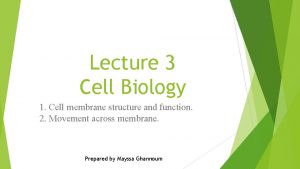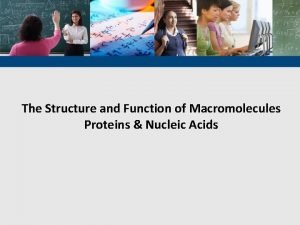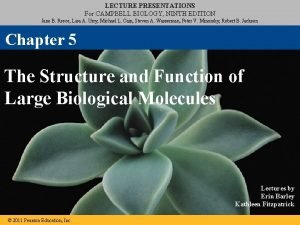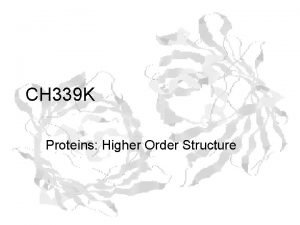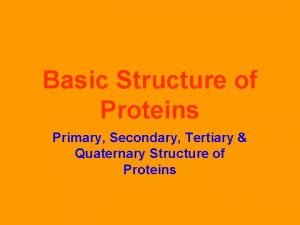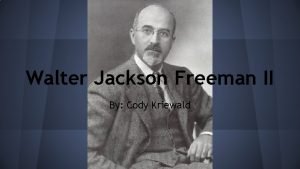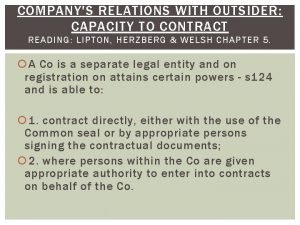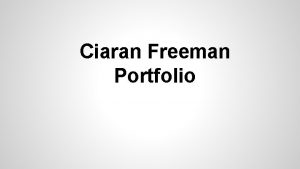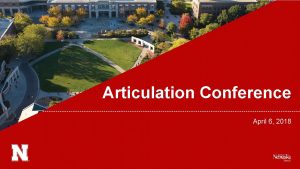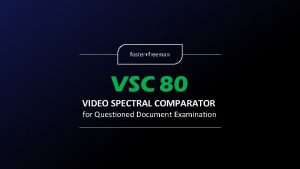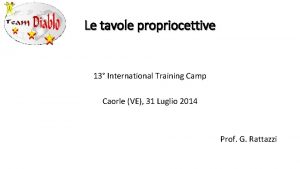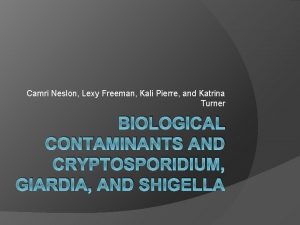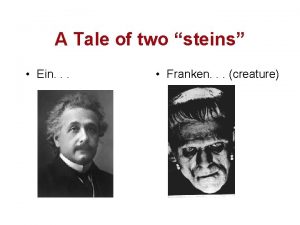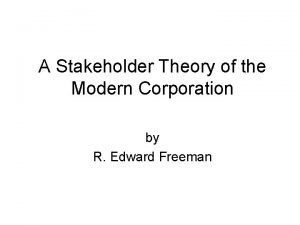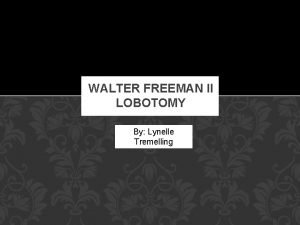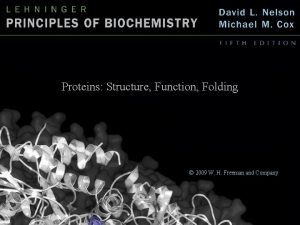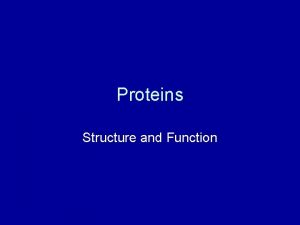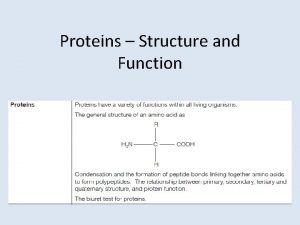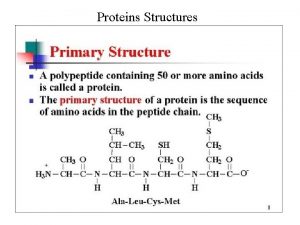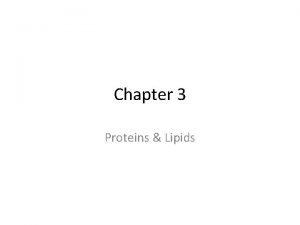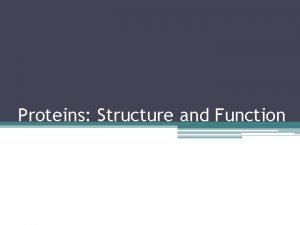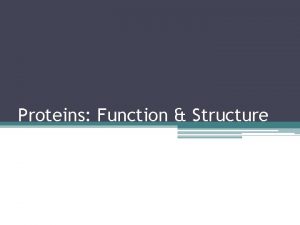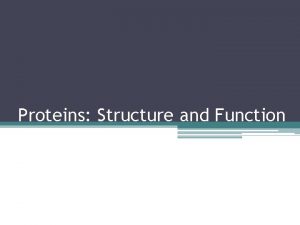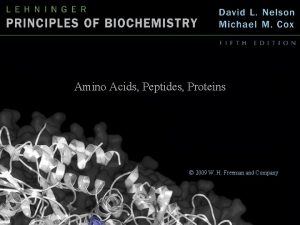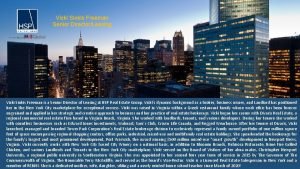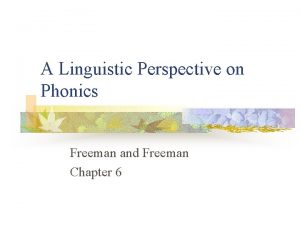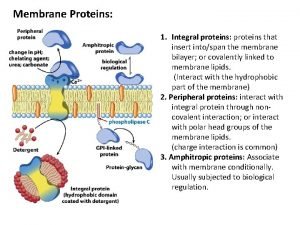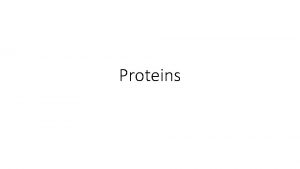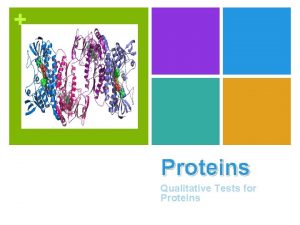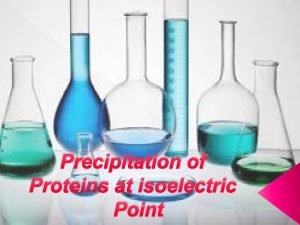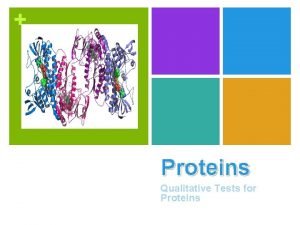Proteins Structure Function Folding2 2009 W H Freeman


















- Slides: 18

Proteins: Structure, Function, Folding-2 © 2009 W. H. Freeman and Company

Fibrous Proteins: From Structure to Function Structure Example Tough, rigid, hard (nails, horns) Cross-linked a-helixes Rigid linker (S—S) a-keratin Tensile strength, non-stretching (tendons, cartilage) Cross-linked triple-helixes Flexible linker (Lys-Hy. Lys) Collagen Soft, flexible non-stretchy (egg sac, nest, web) Non-covalently held b-sheets van der Waals interaction Silk fibroin

Structure of Collagen • Collagen is an important constituent of connective tissue: tendons, cartilage, bones, cornea of the eye • Each collagen chain is a long Gly- and Pro-rich left-handed helix • Three collagen chains intertwine into a righthanded superhelical triple helix • The triple helix has higher tensile strength than a steel wire of equal cross section • Many triple-helixes assemble into a collagen fibril

Silk Fibroin • Fibroin is the main protein in silk from moths and spiders • Antiparallel b sheet structure • Small side chains (Ala and Gly) allow the close packing of sheets • Structure is stabilized by – hydrogen bonding within sheets – London dispersion interactions between sheets

Spider Silk • Used for webs, egg sacks, and wrapping the prey • Extremely strong material – stronger than steel – can stretch a lot before breaking • A composite material – crystalline parts (fibroin-rich) – rubber-like stretchy parts

Motifs (folds) Arrangements of several secondary structure elements Two common ways to form parallel b-sheets

Quaternary Structure • Quaternary structure is formed by spontaneous assembly of individual polypeptides into a larger functional cluster

Functions of Globular Proteins • Storage of ions and molecules – myoglobin, ferritin • Transport of ions and molecules – hemoglobin, serotonin transporter • Defense against pathogens – antibodies, cytokines • Muscle contraction – actin, myosin • Biological catalysis – chymotrypsin, lysozyme

Interaction with Other Molecules • Reversible, transient process of chemical equilibrium: A + B AB • A molecule that binds is called a ligand (typically a small molecule) • A region in the protein where the ligand binds is called the binding site • Ligand binds via non-covalent forces, which enables the interactions to be transient

Specificity: Lock-and-Key Model • Proteins typically have high specificity: only certain ligands bind • High specificity can be explained by the complementary of the binding site and the ligand. • Complementarity in – size, – shape, – charge, – or hydrophobic / hydrophilic character • “Lock and Key” model by Emil Fisher (1894) assumes that complementary surfaces are preformed. +

Specificity: Induced Fit • Conformational changes may occur upon ligand binding (Daniel Koshland in 1958). – This adaptation is called the induced fit. – Induced fit allows for tighter binding of the ligand – Induced fit can increase the affinity of the protein for a second ligand • Both the ligand the protein can change their conformations +

Myoglobin and Hemoglobin • Myoglobin is a monomeric protein and binds molecular oxygen and carry to muscle tissues. Muscle cells use myoglobin to exchange oxygen during active respiration. • Hemoglobin is a tetrameric protein and binds molecular oxygen on RBCs. Being a tetramer it binds four oxygen molecules and distribute them throughout the whole body. It serves to deliver oxygen needed for cellular metabolism and removes the resulting waste product, carbon dioxide from the body tissues. – Human hemoglobin is composed of two α (alpha) and two β (beta) subunits.

Function of Myoglobin • Need to store oxygen for metabolism • Protein side-chains lack affinity for O 2 • Some transition metals bind O 2 well but would generate free radicals if free in solution • Organometallic compounds such as heme are more suitable but Fe 2+ in free heme could be oxidized to Fe 3+ if two heme molecules share an oxygen molecule • Solution: – Capture the oxygen molecule with heme that is sequestered inside the protein – In mammals, myoglobin is the main oxygen storage protein

Hemoglobin • Hemoglobin is a tetramer of two subunits (a 2 b 2) • Each subunit is similar to myoglobin

R and T States of Hemoglobin • T = Tense state, O 2 binding triggers a T R conformational change • R = Relaxed state, this state has higher affinity for O 2 than the T state • Deoxyhemoglobin subunits are more stable in the T state • Conformational change from the T state to the R state involves breaking ion pairs between the a 1 -b 2 interface

How Can Affinity to Oxygen Change Like This? • Must be a protein with multiple binding sites • Binding sites must be able to interact with each other • This phenomenon is called cooperativity – positive cooperativity: first binding event increases affinity at remaining sites – negative cooperativity: first binding event reduces affinity at remaining sites Positive cooperativity can be recognized by sigmoidal binding curves

p. H Effect on O 2 binding to Hemoglobin • Blood in lungs has higher p. H than blood in capillaries of metabolic tissues • Affinity for oxygen depends on the p. H – Oxygen binds well at higher p. H – Oxygen is released well at lower p. H • The p. H difference between lungs and metabolic tissues increases the O 2 transfer efficiency • This is known as the Bohr effect

Hemoglobin and CO 2 Export • CO 2 is produced by metabolism in tissues and must be exported • Some CO 2 exported as dissolved bicarbonate in the blood • Some CO 2 is exported in the form of a carbamate on the amino terminal residues of each of the polypeptide subunits. • Notice that the formation of a carbamate yields a proton which can bind to hemoglobin and promote oxygen dissociation
 Exocytosis definition biology
Exocytosis definition biology Structural proteins function
Structural proteins function Storage proteins function
Storage proteins function Higher order structure of proteins
Higher order structure of proteins Primary secondary tertiary quaternary structure of proteins
Primary secondary tertiary quaternary structure of proteins Example of lipids monomer
Example of lipids monomer Walter freeman ii
Walter freeman ii Crabtree-vickers v australian direct mail
Crabtree-vickers v australian direct mail Ciaran freeman
Ciaran freeman Abby freeman unl
Abby freeman unl Kanapka low commitment projects
Kanapka low commitment projects Stoner dan freeman
Stoner dan freeman Foster and freeman vsc 80
Foster and freeman vsc 80 Edward freeman
Edward freeman Tavole propriocettive
Tavole propriocettive Kali freeman
Kali freeman Morgan freeman almighty
Morgan freeman almighty Friedman and freeman theory
Friedman and freeman theory Helen mortensen lobotomy
Helen mortensen lobotomy
